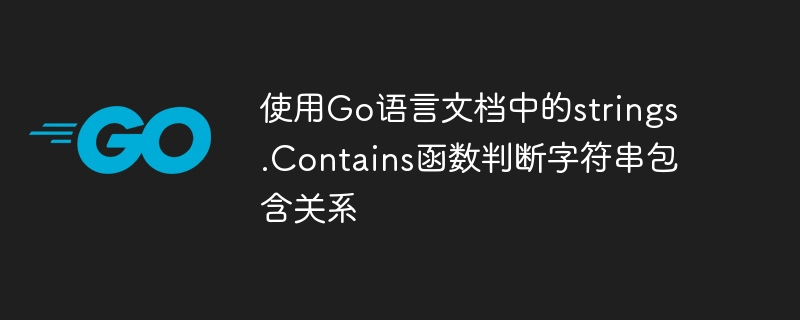使用Go語言文件中的strings.Contains函數判斷字串包含關係
- WBOYWBOYWBOYWBOYWBOYWBOYWBOYWBOYWBOYWBOYWBOYWBOYWB原創
- 2023-11-04 08:50:281061瀏覽

使用Go語言文件中的strings.Contains函數判斷字串包含關係
標題:Go語言中使用strings.Contains函數判斷字串包含關係的範例
在Go語言中,字串的處理是常見的運算之一。而判斷一個字串是否包含另一個字串也是經常遇到的需求。 Go語言提供了strings包,其中的Contains函數可以用來判斷一個字串是否包含另一個字串。以下將詳細介紹如何使用strings.Contains函數來實作字串的包含關係判斷。
首先,我們需要導入strings套件:
import "strings"
接下來,我們就可以使用Contains函數進行字串包含關係的判斷了。 Contains函數的呼叫方式如下所示:
func Contains(s, substr string) bool
其中,s表示要搜尋的字串,substr表示要尋找的子字串。函數的回傳值是一個bool型,表示s是否包含substr。
下面,我們來看一個具體的例子,假設我們有一個字串s,我們想判斷該字串是否包含子字串"hello":
package main
import (
"fmt"
"strings"
)
func main() {
s := "hello world"
if strings.Contains(s, "hello") {
fmt.Println("字符串s包含子字符串"hello"")
} else {
fmt.Println("字符串s不包含子字符串"hello"")
}
}在上面的程式碼中,我們使用Contains函數來判斷字串s是否包含子字串"hello"。如果包含,則列印"字串s包含子字串"hello"";否則,列印"字串s不包含子字串"hello""。
執行上述程式碼,輸出結果為"字串s包含子字串"hello"",因為字串"hello world"中包含子字串"hello"。
除了判斷單一子字串,我們還可以透過多次呼叫Contains函數來判斷字串是否包含多個子字串。例如,我們有一個字串s,我們想要判斷該字串是否同時包含子字串"hello"和"world":
package main
import (
"fmt"
"strings"
)
func main() {
s := "hello world"
if strings.Contains(s, "hello") && strings.Contains(s, "world") {
fmt.Println("字符串s同时包含子字符串"hello"和"world"")
} else {
fmt.Println("字符串s不同时包含子字符串"hello"和"world"")
}
}在上述程式碼中,我們透過多次呼叫Contains函數來判斷字串s是否同時包含子字串"hello"和"world"。如果同時包含,則列印"字串s同時包含子字串"hello"和"world"";否則,列印"字串s不同時包含子字串"hello"和"world""。
執行上述程式碼,輸出結果為"字串s同時包含子字串"hello"和"world"",因為字串"hello world"同時包含子字串"hello"和"world" 。
透過以上的範例,我們可以看到使用Go語言中的strings.Contains函數可以方便地判斷字串是否包含其他字串。在實際的開發中,我們可以根據實際情況靈活運用函數,完成字串的包含關係判斷。
以上是使用Go語言文件中的strings.Contains函數判斷字串包含關係的詳細內容。更多資訊請關注PHP中文網其他相關文章!

